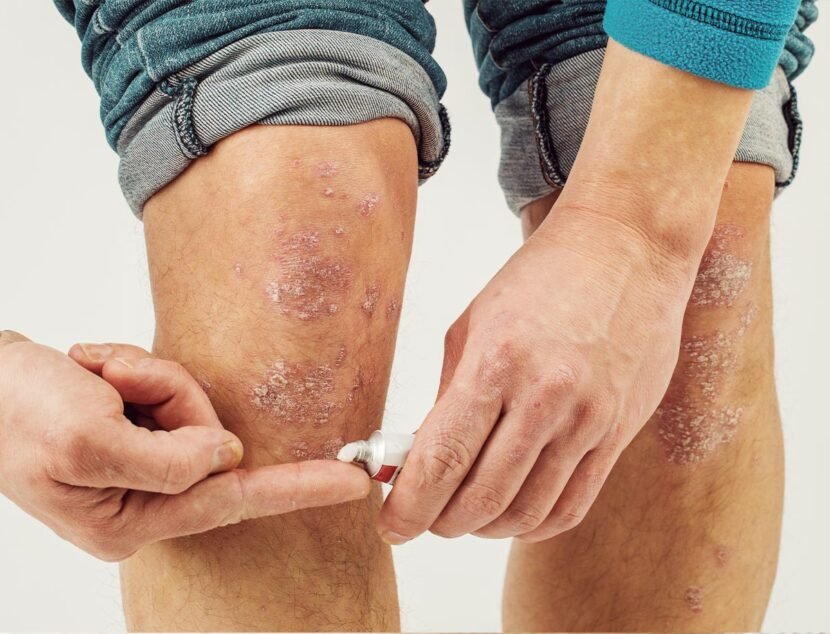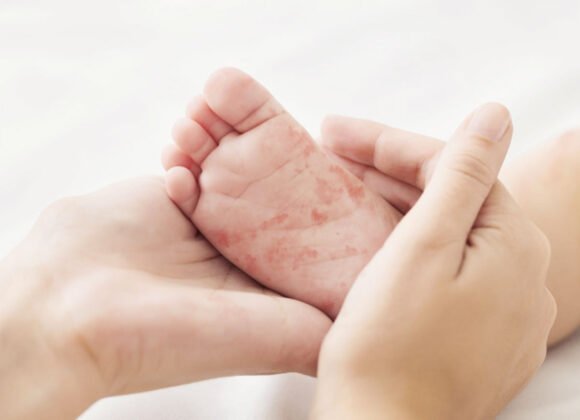Leg eczema, also known as atopic dermatitis, is a chronic skin condition characterized by red, itchy, and inflamed patches on the legs. Symptoms can vary among individuals but typically include dry, scaly skin, red or brownish-gray patches, intense itching, and thickened or cracked skin. These symptoms can cause discomfort and pain, potentially impacting the quality of life for those affected.
The development of leg eczema is influenced by multiple factors, including genetics, environmental triggers, and immune system dysfunction. Genetic predisposition plays a significant role, as the condition often runs in families. Environmental factors such as allergens, irritants, and climate changes can trigger flare-ups.
Additionally, immune system irregularities can lead to skin inflammation and irritation, contributing to eczema development. Understanding the symptoms and triggers of leg eczema is essential for effective management and treatment. By recognizing the signs and identifying potential triggers, individuals can take proactive steps to alleviate symptoms and improve their condition.
This knowledge enables patients to work with healthcare professionals to develop appropriate treatment plans and implement lifestyle modifications that may help reduce the frequency and severity of flare-ups.
Key Takeaways
- Leg eczema symptoms include red, itchy, and inflamed skin, often triggered by irritants or allergens
- Common triggers of leg eczema include harsh soaps, detergents, and certain fabrics
- Effective treatments for leg eczema include moisturizing creams, topical steroids, and antihistamines
- Managing itchy skin associated with leg eczema can be done through cold compresses and avoiding scratching
- Lifestyle changes such as wearing loose-fitting clothing and using mild, fragrance-free products can help prevent and manage leg eczema
Identifying Common Causes of Leg Eczema
Dry Skin and Environmental Factors
One common cause of leg eczema is dry skin, which can be exacerbated by factors such as cold weather, low humidity, and harsh soaps or detergents. Dry skin can lead to itching and irritation, which can trigger flare-ups of leg eczema.
Allergens and Irritants
Another common cause of leg eczema is allergens, such as dust mites, pet dander, pollen, and mold. These allergens can come into contact with the skin and cause an allergic reaction, leading to redness, itching, and inflammation. Additionally, irritants such as soaps, detergents, and skincare products with fragrances or harsh chemicals can also trigger leg eczema flare-ups.
Stress and Hormonal Changes
Stress is another common cause of leg eczema, as it can weaken the immune system and lead to increased inflammation in the body. Hormonal changes, such as those experienced during pregnancy or menopause, can also trigger flare-ups of leg eczema.
Effective Treatments for Leg Eczema
There are several effective treatments for leg eczema that individuals can explore to alleviate their symptoms and improve their quality of life. One common treatment is the use of moisturizers to keep the skin hydrated and prevent dryness and itching. Moisturizers with ingredients such as ceramides, hyaluronic acid, and glycerin can help repair the skin barrier and reduce inflammation.
Topical corticosteroids are another effective treatment for leg eczema, as they can help reduce inflammation and itching. These medications come in varying strengths and should be used under the guidance of a healthcare professional to minimize potential side effects. Additionally, topical calcineurin inhibitors can be used to reduce inflammation and itching in individuals with moderate to severe leg eczema.
For individuals with severe or persistent leg eczema, oral medications such as antihistamines or oral corticosteroids may be prescribed by a healthcare professional. These medications can help alleviate itching and inflammation from the inside out. In some cases, phototherapy or light therapy may be recommended to help reduce inflammation and improve the appearance of the skin.
Managing Itchy Skin Associated with Leg Eczema
Itchy skin is a common symptom of leg eczema that can be uncomfortable and disruptive to daily life. There are several strategies individuals can use to manage itchy skin associated with leg eczema. One effective method is the use of cold compresses or ice packs to numb the skin and reduce itching.
Applying a cold compress to itchy areas for a few minutes at a time can provide temporary relief from itching. Another strategy for managing itchy skin associated with leg eczema is the use of anti-itch creams or ointments. These products typically contain ingredients such as hydrocortisone or pramoxine, which can help reduce itching and inflammation.
It is important to use these products as directed and avoid overuse to minimize potential side effects. Keeping the skin moisturized is also crucial in managing itchy skin associated with leg eczema. Using a thick, fragrance-free moisturizer regularly can help prevent dryness and itching.
Additionally, taking short, lukewarm baths or showers with gentle cleansers can help soothe itchy skin and prevent further irritation.
Lifestyle Changes to Help Prevent and Manage Leg Eczema
In addition to medical treatments, making lifestyle changes can help prevent and manage leg eczema. One important lifestyle change is to identify and avoid triggers that exacerbate leg eczema symptoms. This may include avoiding harsh soaps or detergents, minimizing exposure to allergens such as dust mites or pet dander, and managing stress through relaxation techniques or therapy.
Wearing loose-fitting clothing made from soft, breathable fabrics such as cotton can also help prevent irritation and itching associated with leg eczema. Additionally, individuals with leg eczema should avoid scratching affected areas, as this can further irritate the skin and lead to infection. Using gentle skincare products without fragrances or harsh chemicals can also help prevent flare-ups of leg eczema.
Maintaining a healthy diet rich in fruits, vegetables, lean proteins, and whole grains can also support overall skin health and reduce inflammation associated with leg eczema. Staying hydrated by drinking plenty of water throughout the day can also help keep the skin hydrated and prevent dryness.
Seeking Professional Help for Severe Cases of Leg Eczema
Customized Treatment Options
Professional treatments for severe leg eczema may include prescription-strength topical medications, oral medications, or biologic therapies that target the immune system. These treatments can provide more effective relief from symptoms and help individuals manage their condition more effectively.
Identifying Triggers through Allergy Testing
Individuals with severe leg eczema may benefit from allergy testing to identify specific triggers that exacerbate their symptoms. This can help them avoid or minimize exposure to these triggers, reducing the severity of their symptoms.
Comprehensive Care for Severe Leg Eczema
In some cases, individuals with severe leg eczema may be referred to a multidisciplinary team including dermatologists, allergists, and mental health professionals. This comprehensive approach addresses all aspects of their condition, helping individuals effectively manage their symptoms and improve their quality of life.
The Importance of Consistent Skincare in Managing Leg Eczema
Consistent skincare is crucial in managing leg eczema and preventing flare-ups. This includes using gentle cleansers and moisturizers daily to keep the skin hydrated and prevent dryness. It is important to apply moisturizer immediately after bathing or showering to lock in moisture and protect the skin barrier.
Individuals with leg eczema should also avoid hot water when bathing or showering, as this can strip the skin of its natural oils and lead to dryness and irritation. Using lukewarm water and limiting bathing or showering time to 10-15 minutes can help prevent further damage to the skin. In addition to consistent skincare, individuals with leg eczema should avoid harsh scrubbing or exfoliating the skin, as this can exacerbate inflammation and lead to further irritation.
Using soft towels to pat the skin dry after bathing or showering can also help prevent irritation. In conclusion, understanding the symptoms and triggers of leg eczema is crucial in effectively managing the condition. By identifying common causes of leg eczema, individuals can take proactive steps in minimizing their exposure to triggers and effectively managing their symptoms.
Effective treatments for leg eczema include moisturizers, topical corticosteroids, oral medications, and phototherapy. Managing itchy skin associated with leg eczema involves using cold compresses, anti-itch creams or ointments, and keeping the skin moisturized. Lifestyle changes such as avoiding triggers, wearing soft clothing, maintaining a healthy diet, and staying hydrated can help prevent and manage leg eczema.
For severe cases of leg eczema, seeking professional help from a dermatologist or healthcare professional specializing in skin conditions is crucial. Consistent skincare is important in managing leg eczema and preventing flare-ups. By implementing these strategies, individuals with leg eczema can effectively manage their condition and improve their quality of life.
FAQs
What is leg eczema?
Leg eczema, also known as stasis dermatitis or venous eczema, is a type of eczema that occurs on the lower legs. It is often associated with poor circulation and can cause redness, itching, swelling, and flaking of the skin.
What are the common causes of leg eczema?
Common causes of leg eczema include poor circulation, varicose veins, obesity, aging, and a history of blood clots. Other factors such as allergies, irritants, and genetics can also contribute to the development of leg eczema.
How is leg eczema diagnosed?
Leg eczema is typically diagnosed through a physical examination by a healthcare professional. In some cases, a skin biopsy or patch testing may be performed to confirm the diagnosis and identify any potential triggers.
What are the effective treatments for leg eczema?
Effective treatments for leg eczema may include moisturizing creams, topical corticosteroids, antihistamines, and compression stockings to improve circulation. In severe cases, oral medications or light therapy may be recommended. It is important to consult a healthcare professional for personalized treatment options.
Can lifestyle changes help manage leg eczema?
Yes, lifestyle changes such as maintaining a healthy weight, elevating the legs when resting, avoiding long periods of standing or sitting, and wearing loose-fitting clothing can help manage leg eczema. Additionally, identifying and avoiding triggers such as certain fabrics or skincare products can also be beneficial.




